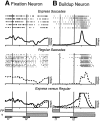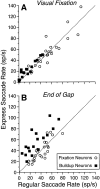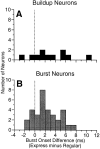Neuronal activity in monkey superior colliculus related to the initiation of saccadic eye movements
- PMID: 9334428
- PMCID: PMC6573744
- DOI: 10.1523/JNEUROSCI.17-21-08566.1997
Neuronal activity in monkey superior colliculus related to the initiation of saccadic eye movements
Abstract
The introduction of a temporal gap between the disappearance of an initially fixated target and the appearance of an eccentric saccadic target results in a general reduction of saccadic reaction times (SRTs)-the gap effect-and often in the production of express saccades, the latencies of which approach the conduction time of the shortest neural pathways from the retina to the eye muscles. We investigated saccade initiation by recording neuronal activity in the superior colliculus in monkeys performing the gap paradigm. Fixation-related neurons reduced their discharge rate during the gap period, regardless of the SRT. This reduction in activity is consistent with the hypothesized release of ocular fixation that facilitates premotor processes and may contribute to the gap effect. In addition to saccade-related discharges, many saccade-related neurons displayed phasic target-related responses and/or low-frequency preparatory activity during the gap period. The level of this preparatory activity correlated with both SRT and express saccade occurrence when the saccade was made into the response field of the neuron. Evidence indicates that advanced motor preparation is required for express saccade generation, which may be subserved by specific increases in the preparatory activity of saccade-related neurons. Increased preparatory activity may allow the target-related responses to trigger short-latency express saccades directly. This study provides insights into the functional mechanism of saccade initiation and may be relevant to the generation of all voluntary motor responses.
Figures













References
-
- Becker W. Metrics. In: Wurtz RH, Goldberg ME, editors. The neurobiology of saccadic eye movements. Elsevier; Amsterdam: 1989. pp. 13–67. - PubMed
-
- Boch R, Fischer B. Further observations on the occurrence of express-saccades in the monkey. Exp Brain Res. 1986;63:487–494. - PubMed
-
- Carpenter RHS. Oculomotor procrastination. In: Fischer DF, Monty RA, editors. Eye movements: cognition and visual perception. Erlbaum; Hillsdale, NJ: 1981. pp. 237–246.
-
- Carpenter RHS, Williams MLL. Neural computation of log likelihood in control of saccadic eye movements. Nature. 1995;377:59–62. - PubMed
-
- Chou I, Sommer MA, Schiller PH. Bimodal latency distribution of averaging saccades in monkey. Soc Neurosci Abstr. 1994;20:1401.
Publication types
MeSH terms
LinkOut - more resources
Full Text Sources
Miscellaneous
